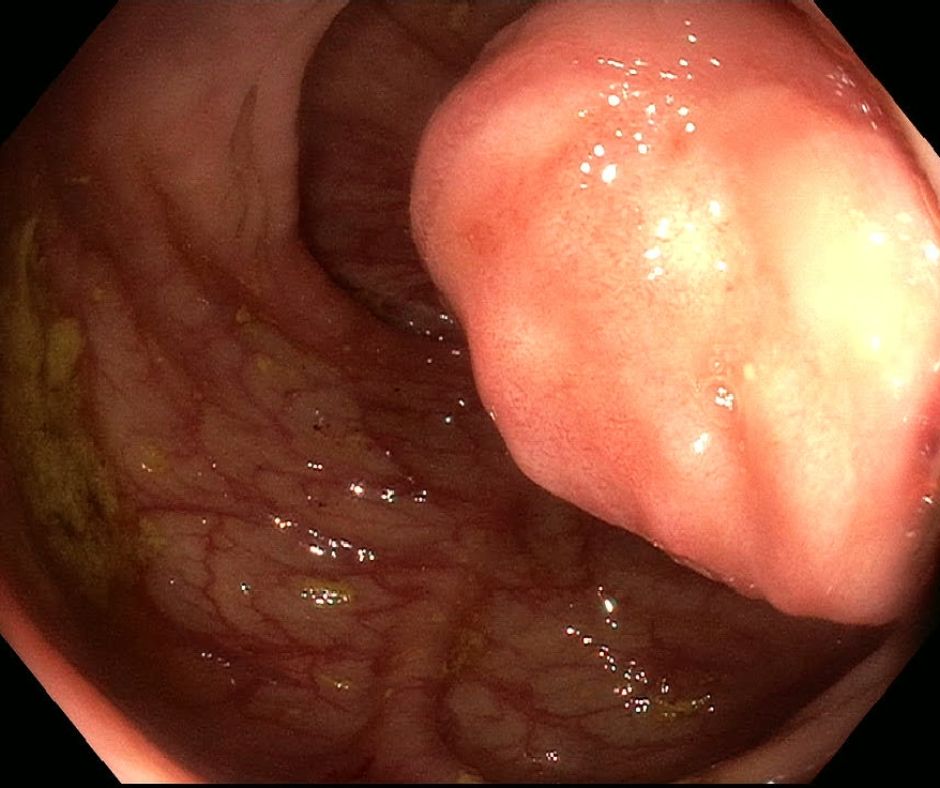Tuesday Poster Session
Category: Colon
P3809 - Liposarcoma Found in the Cecum With Renal Capsule Involvement
Tuesday, October 29, 2024
10:30 AM - 4:00 PM ET
Location: Exhibit Hall E

Has Audio

Jason T. Farrell, DO
Reading Hospital - Tower Health
Reading, PA
Presenting Author(s)
Jason T. Farrell, DO, Iman Waheed Khan, MD, Kevin Gordon, MD
Reading Hospital - Tower Health, Reading, PA
Introduction: Liposarcoma is a common soft tissue sarcoma in adults and is mostly localized in the extremities and the retroperitoneum. Primary liposarcoma incidence in gastrointestinal tract is approximately 2 %, and incidence in the colon is even more rare. It has been described that surgical excision is the cornerstone of treatment for liposarcoma of the colon with favorable outcomes but there is no consensus on adjuvant therapies. We present a case of a primary liposarcoma of the colon presenting as a large cecal intraluminal lesion.
Case Description/Methods: We describe a case of a 63-year-old male with past medical history of sleep apnea, hypertension, type 2 diabetes who presented to the Emergency department with rectal bleeding. On presentation the patient had symptoms of hematochezia, passage of clots. He did not report any abdominal pain. Of note, his prior colonoscopy was in 2018 and showed small internal hemorrhoids, with a 10-year recall recommended. He was hypertensive and tachycardic on presentation with labs notable for hemoglobin of 11.6 from a normal baseline. CT scan showed hepatomegaly with severe hepatic steatosis, colonic diverticulosis without diverticulitis, and a left inguinal hernia containing fat. The patient underwent a colonoscopy which revealed mild sigmoid diverticulosis, internal hemorrhoids, and a large broad-based cecal polyp vs mass > 4 cm in size. This was biopsied and the pathology showed at least well-differentiated liposarcoma. The patient underwent a right hemicolectomy and partial resection of the right kidney capsule as the mass adhered to the right kidney’s surface. Pathology revealed grade 3 dedifferentiated liposarcoma. Regional lymph nodes/ renal parenchyma were negative. Patient continued to follow oncology without undergoing adjuvant therapy.
Discussion: Liposarcoma of the colon is rare and can sporadically appear in patients making it difficult to screen for. Our patient had a normal colonoscopy in 2018, yet the cancer appeared within 5 years of the last scope. To date, we have found 2 other cases presenting in the cecum. While one of them remained localized to cecum, the other invaded the surrounding mesentery and ileocecal vessel requiring mesenteric resection along with hemicolectomy. Our case had invasion of kidney capsule, thankfully sparing the kidney parenchyma. More studies need to be done to understand what features and level of differentiation of such tumors leads to invasiveness.

Disclosures:
Jason T. Farrell, DO, Iman Waheed Khan, MD, Kevin Gordon, MD. P3809 - Liposarcoma Found in the Cecum With Renal Capsule Involvement, ACG 2024 Annual Scientific Meeting Abstracts. Philadelphia, PA: American College of Gastroenterology.
Reading Hospital - Tower Health, Reading, PA
Introduction: Liposarcoma is a common soft tissue sarcoma in adults and is mostly localized in the extremities and the retroperitoneum. Primary liposarcoma incidence in gastrointestinal tract is approximately 2 %, and incidence in the colon is even more rare. It has been described that surgical excision is the cornerstone of treatment for liposarcoma of the colon with favorable outcomes but there is no consensus on adjuvant therapies. We present a case of a primary liposarcoma of the colon presenting as a large cecal intraluminal lesion.
Case Description/Methods: We describe a case of a 63-year-old male with past medical history of sleep apnea, hypertension, type 2 diabetes who presented to the Emergency department with rectal bleeding. On presentation the patient had symptoms of hematochezia, passage of clots. He did not report any abdominal pain. Of note, his prior colonoscopy was in 2018 and showed small internal hemorrhoids, with a 10-year recall recommended. He was hypertensive and tachycardic on presentation with labs notable for hemoglobin of 11.6 from a normal baseline. CT scan showed hepatomegaly with severe hepatic steatosis, colonic diverticulosis without diverticulitis, and a left inguinal hernia containing fat. The patient underwent a colonoscopy which revealed mild sigmoid diverticulosis, internal hemorrhoids, and a large broad-based cecal polyp vs mass > 4 cm in size. This was biopsied and the pathology showed at least well-differentiated liposarcoma. The patient underwent a right hemicolectomy and partial resection of the right kidney capsule as the mass adhered to the right kidney’s surface. Pathology revealed grade 3 dedifferentiated liposarcoma. Regional lymph nodes/ renal parenchyma were negative. Patient continued to follow oncology without undergoing adjuvant therapy.
Discussion: Liposarcoma of the colon is rare and can sporadically appear in patients making it difficult to screen for. Our patient had a normal colonoscopy in 2018, yet the cancer appeared within 5 years of the last scope. To date, we have found 2 other cases presenting in the cecum. While one of them remained localized to cecum, the other invaded the surrounding mesentery and ileocecal vessel requiring mesenteric resection along with hemicolectomy. Our case had invasion of kidney capsule, thankfully sparing the kidney parenchyma. More studies need to be done to understand what features and level of differentiation of such tumors leads to invasiveness.

Figure: Liposarcoma of Cecum
Disclosures:
Jason Farrell indicated no relevant financial relationships.
Iman Waheed Khan indicated no relevant financial relationships.
Kevin Gordon indicated no relevant financial relationships.
Jason T. Farrell, DO, Iman Waheed Khan, MD, Kevin Gordon, MD. P3809 - Liposarcoma Found in the Cecum With Renal Capsule Involvement, ACG 2024 Annual Scientific Meeting Abstracts. Philadelphia, PA: American College of Gastroenterology.
